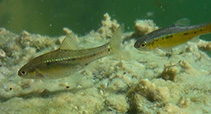| Distribution: |
Africa: endemic to the eastern Cape Fold Ecoregion in South Africa, where it is distributed from the Krom to the Great Fish river system (Ref. 52193, 122070). Specimens identified as Enteromius pallidus from tributaries of the Orange-Vaal, Tugela, Mfolozi, Pongolo, Incomati and Limpopo rivers (Ref. 7248, 13332) are not related and should be treated as misidentifications (Ref. 122070). |
| Diagnosis: |
Dorsal spines (total): 0-0; Dorsal soft rays (total): 10-10; Anal spines: 0-0; Anal soft rays: 8-8. Diagnosis: Enteromius pallidus can be identified by the slightly convex dorsal surface; posterior barbel 2.0 to 3.0 times the length of anterior barbel; a slightly prominent snout; an incomplete lateral line; deep translucent light brown to golden sheen with the presence of irregular and scattered spots in mature adults; and the presence of 3-7 bold spots above the lateral line in juveniles and subadults (Ref. 122070). This species belongs to the group of Enteromius species in southern Africa that is characterised by a simple and flexible unbranched primary dorsal fin ray (Ref. 122070). It is distinguished from E. amatolicus, E. anoplus, E. annectens, E. toppini and E. radiatus by possession of two pairs of prominent and long barbels vs. single pair and/or minute oral barbels in other species; it is distinguished from E. lineomaculatus, E. viviparus and E. unitaeniatus by absence of distinct chevron markings on the lateral line vs. presence of conspicuous chevron markings on the lateral line in the other three species, and from E. bifrenatus by absence of a distinct lateral stripe and absence of black tubular markings around lateral line pores vs. presence in E. bifrenatus; it is distinguished from E. anoplus, E. amatolicus, E. annectens, E. unitaeniatus, E. bifrenatus, E. gurneyi, E. motebensis, E. radiatus, E. toppini, E. treurensis and E. viviparus by the presence of scattered black spots on the body, particularly in juveniles vs. absence of scattered black spots in the other species (Ref. 122070). Lateral pigmentation pattern of E. pallidus is closely similar to that of E. brevipinnis and E. neefi, but it is distinguished from these two species by having an incomplete lateral line vs. complete lateral line in both E. neefi and E. brevipinnis; it is further separated from E. neefi by absence of wavy lines along the scale rows vs. presence of conspicuous wavy lines along the scale rows in E. neefi, and from E. brevipinnis by lack of black pigmentation around the borders of the scales vs. presence of distinct black pigmentation around the scales in E. brevipinnis, giving a mesh-like pattern on the lateral side of the fish (Ref. 122070).
Description: Body fusiform, moderately compressed laterally; with four visible, irregular spots above lateral line (Ref. 122070). Dorsal profile slightly convex from tip of snout to origin of dorsal fin; anterior-projection slightly pronounced; body depth greatest between dorsal fin and anal fin origin, tapering from posterior margin of dorsal fin base to base of caudal fin; ventral profile slightly concave, curving downwards from operculum to origin of pelvic fin base, slightly tapering to posterior end of anal fin base, then slightly concave to caudal fin (Ref. 122070). Head relatively small and slightly projected; 0.2 times standard length, head length sub-equal to body depth; eye relatively large and round; located dorsolaterally, closer to tip of snout than distal margin of operculum, interorbital space slightly convex; snout rounded, shorter than post-orbital length; sub-equal or less than eye diameter; nuptial tubercles absent (Ref. 122070). Mouth inferior; upper jaw sub-equal to ower jaw; lip simple and thin; lower lip unretracted; two pairs of barbels; rostral, anterior, barbels minute, reaching past posterior end of nostril, 0.3 times in length of eye diameter; maxillary, posterior, barbels 3.0 times longer than rostral barbels, reaching beyond vertical through middle of eye (Ref. 122070). Dorsal fin with 3 simple unbranched and 7 branched rays; distal margin almost straight; origin centered vertically with origin of pelvic fins; pectoral fin with 1 simple unbranched and 7 branched rays; posterior edge gently rounded, not reaching pelvic fin origin; pelvic fin with 1 simple unbranched and 5 branched rays; posterior edge gently rounded, almost reaching anus; origin midway between pectoral fin origin and anal fin origin; anal fin with 3 unbranched and 5 branched rays; distal margin almost straight; origin inserted closer to origin of pelvic fin than base of caudal fin; caudal fin bifurcate; with two pairs of 1 simple unbranched ray, 8 or 9 branched rays on each lobe (Ref. 122070). Scales moderately large, radiately striated; lateral line incomplete, with 4-13 perforated scales, 23-31 lateral scale series; 3-5 scale rows between dorsal fin origin and lateral line; 2-5 scale rows between pelvic fin origin and lateral line; 2-3 scale rows between lateral line and anal fin origin; 12 circumpeduncular scae rows; 7-14 predorsal scale rows, embedded in skin, smaller than flank scales; scales between posterior base of pectoral fins and anterior base of pelvic fins smaller than flank scales and embedded (Ref. 122070).
Colouration: In life, the colour for both adult breeding males and females is deep greenish-brown with a golden sheen dorsally, golden-yellow laterally and silvery ventrally; fins are translucent-yellow; juveniles appear brown laterally and silvery ventrally; black spots are present above the lateral line, with juveniles and sub-adults having bold or more prominent spots in comparison to adults which tend to have fewer and often less conspicuous spots or blotches; all juveniles and sub-adults had at least 3 bold spots above the lateral line on both sides; at least one bold spot is consistently found within the pre-dorsal region, pre-anal and caudal regions, a dark spot is always present on vertical through dorsal fin insertion and at the base of the caudal peduncle (Ref. 122070). Alcohol preserved specimens appear either plain silvery, or dusky grey dorsally and laterally and cream-yellowish ventrally; the black spots become more prominent in preserved specimens; black pigmentation at the anterior base of the anal fin is more prominent in juveniles and sub-adults compared to adults (Ref. 122070). |
